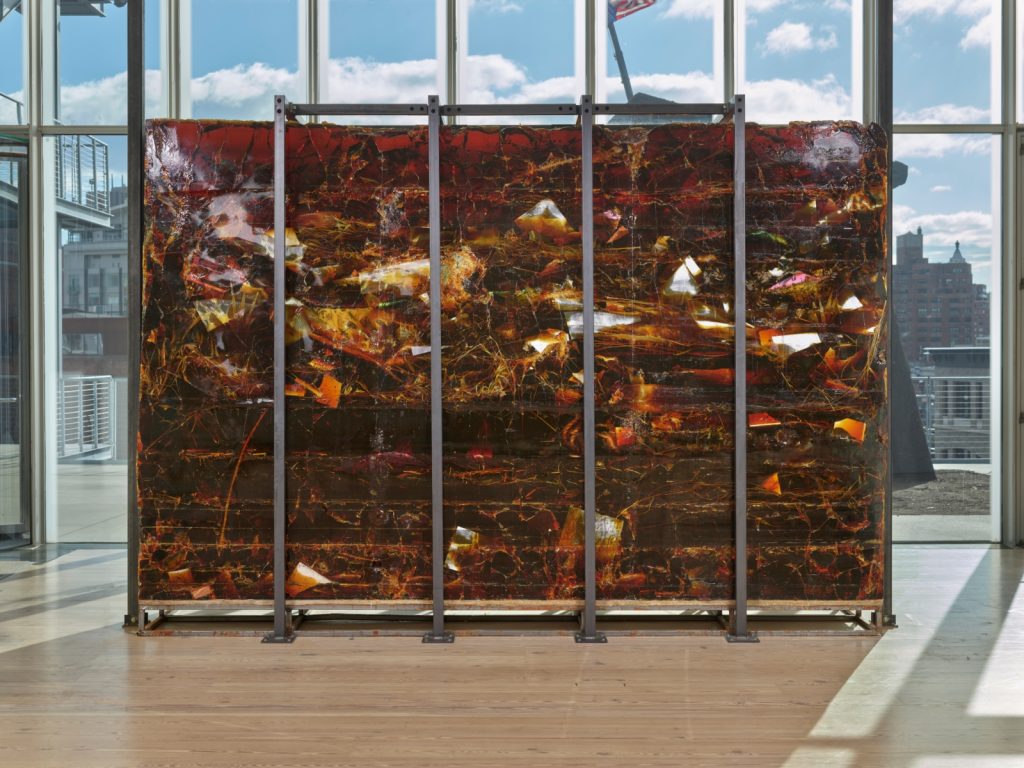Amid this year’s Whitney Biennial, which is a recurring exhibition at the Whitney Museum of American Art in New York City, I saw the sculptural piece “Paloma Blanca Deja Volar/White Dove Let Us Fly” multiple times. It’s a 2024 artwork by Los Angeles artist Eddie Rodolfo Aparicio.
And it’s unlike anything I’ve ever seen before, which, on its own, is always a major plus for me. As a whole, this year’s exhibition at the Whitney featured a lot of that, whether in the form of fresh uses of materials, a video artwork playing across five screens at once, or fabric dyed with richly red clay from the Abraham River in Lebanon.
The Materials of Aparicio’s Sculpture
Aparicio’s artwork was comprised, most prominently, of amber, which is what tree resin becomes if you leave it for a while. My own memories of encountering the substance begin with images of insects stuck indefinitely in amber from time immemorial, but here, Aparicio altered the material so that the large chunk of it within a metal frame originally comprising the sculpture gradually fell apart across the months of the biennial. I would guess that it started out around six feet tall and largely intact, and after months of display, that became a strewn, nature-made assemblage of chunks and dust rising not far from the floor.
The Whitney’s informational card for this artwork did not delineate the modification process but said Aparicio’s work meant the amber was “not completely rigid.”
But he wasn’t just manipulating the substance itself. Aparicio also filled the large slab of amber with found items, both natural (like pigeon wings) and the result of human endeavor, like cast aside clothing and documents related to white activists’ work to advance Central American causes.
By the time I saw the artwork for the first time, the falling apart was already well underway, but Aparicio banked on something along those very lines. And the net result was a captivating, quiet rhythm of ruin circulating back into life.

A Clash of Life’s Forces
Although the lumbering chunks of amber lay scattered about like rubble, I never picked up on what I’d call an endpoint. Instead, it was a system that looped back into itself. Whatever the preserving qualities of amber, the sculptural piece couldn’t fix itself, but — even with a slow-motion, extended crash to the floor — it lingered. The sing-song assortment of items inside the amber continued to ring out, contrasting the arguably smothering qualities of the substance in isolation with something surprisingly lively.
The artwork’s persistence suggested defiance in the face of things refusing to fit together in a neat order.
Notably, the nature of what was going on here meant that — for most visitors, at least — a major moment of crashing dissolution was not in the picture. My few visits as the structure settled into an ever-new, cyclical presence seemed to indicate that, for most of the work’s existence so far, it was a gradual, slow process.
On the flip side, I could see how that process could be paralleled to destructive socio-political forces that gradually ratchet upwards in intensity until there are suddenly real-world outbursts of physical violence. But it’s not just that kind of thing.
Just as there was no clear endpoint cutting off opportunities for light, there was — to me — no clear flashpoint in the artwork representing some kind of precise path into an all-encompassing clean slate.
As big as it was, both in scale and uniqueness, the artwork didn’t seem bombastic, instead blending forward motion with grounded weight. You might compute the clash of forces in this artwork as the endlessly forward cycle your eye could trace from point to point versus the inner, physical heft of not just chunks of the amber but those individual segments combined into a field of (eventually) debris.
The formidable amber, whether in its original slab form or how it exists now, extends… everywhere within the artwork’s space. Nothing tapers off or moves aside.
The Whitney’s informational card posted nearby on the wall brought up a concept of the physical body somehow carrying within itself lingering outposts of “memory and trauma.” And I think, in truth, this artwork extends even further than that. If you’re trudging through that kind of a thing, whether on a personal, community-wide, or national level, there’s not necessarily going to be anyplace that it just disappears. It affects your experience of the people around you, your environment, and items in it. There’s a perceptual alignment that extends across parts of your life.
And you learn to live with it. So Aparicio’s piece, I think, astutely reflects an experience of life simultaneously pieced together and disassembling. The sculptural work tees off from real-world architectural concepts and the decay that might follow them, but it doesn’t linger in those rules, instead entering a swirling mental space of lived experience.
The biennial’s end date was August 11, but some of the artwork remains on view at the Whitney’s Meatpacking District location just off the Hudson River. And that includes this piece!

Featured image: same as above
You may also like
-
Diana Kurz at Lincoln Glenn in New York: A Review of a Shining Art Exhibition
-
Dustin Hodges at 15 Orient in New York City: An Ensnaring Exhibition at an Exciting Gallery
-
Maren Hassinger at Susan Inglett Gallery in New York: Reviewing an Uplifting Art Exhibition
-
Enzo Shalom at Bortolami in New York City: Reviewing an Entrancing Exhibition of Paintings
-
“Ben Werther: Townworld” at Amanita in New York City: Reviewing a Richly Memorable Art Exhibition